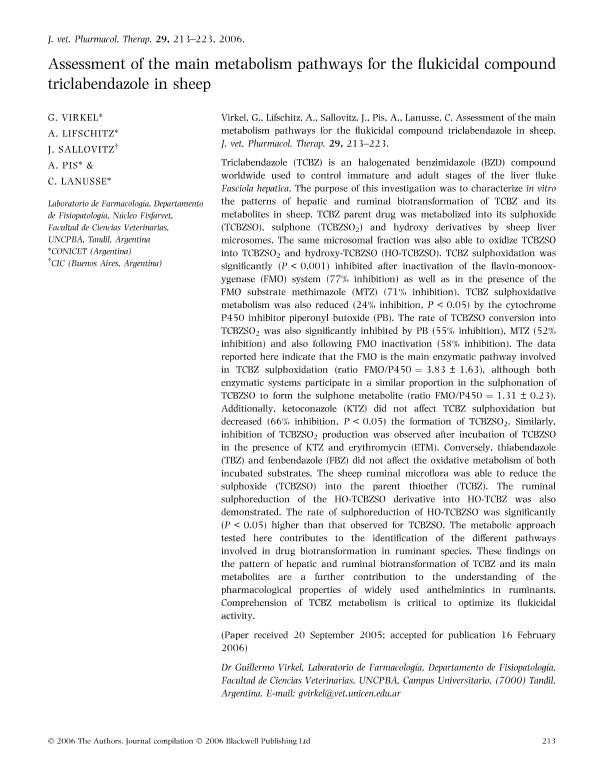Artículo
Assessment of the main metabolism pathways for the flukicidal compound triclabendazole in sheep
Virkel, Guillermo Leon ; Lifschitz, Adrian Luis
; Lifschitz, Adrian Luis ; Sallovitz, Juan Manuel; Pis, Alejandra; Lanusse, Carlos Edmundo
; Sallovitz, Juan Manuel; Pis, Alejandra; Lanusse, Carlos Edmundo
 ; Lifschitz, Adrian Luis
; Lifschitz, Adrian Luis ; Sallovitz, Juan Manuel; Pis, Alejandra; Lanusse, Carlos Edmundo
; Sallovitz, Juan Manuel; Pis, Alejandra; Lanusse, Carlos Edmundo
Fecha de publicación:
06/2006
Editorial:
Wiley Blackwell Publishing, Inc
Revista:
Journal of Veterinary Pharmacology and Therapeutics
ISSN:
0140-7783
e-ISSN:
1365-2885
Idioma:
Inglés
Tipo de recurso:
Artículo publicado
Clasificación temática:
Resumen
Triclabendazole (TCBZ) is an halogenated benzimidazole (BZD) compound worldwide used to control immature and adult stages of the liver fluke Fasciola hepatica. The purpose of this investigation was to characterize in vitro the patterns of hepatic and ruminal biotransformation of TCBZ and its metabolites in sheep. TCBZ parent drug was metabolized into its sulphoxide (TCBZSO), sulphone (TCBZSO2) and hydroxy derivatives by sheep liver microsomes. The same microsomal fraction was also able to oxidize TCBZSO into TCBZSO2 and hydroxy‐TCBZSO (HO‐TCBZSO). TCBZ sulphoxidation was significantly (P < 0.001) inhibited after inactivation of the flavin‐monooxygenase (FMO) system (77% inhibition) as well as in the presence of the FMO substrate methimazole (MTZ) (71% inhibition). TCBZ sulphoxidative metabolism was also reduced (24% inhibition, P < 0.05) by the cytochrome P450 inhibitor piperonyl butoxide (PB). The rate of TCBZSO conversion into TCBZSO2 was also significantly inhibited by PB (55% inhibition), MTZ (52% inhibition) and also following FMO inactivation (58% inhibition). The data reported here indicate that the FMO is the main enzymatic pathway involved in TCBZ sulphoxidation (ratio FMO/P450 = 3.83 ± 1.63), although both enzymatic systems participate in a similar proportion in the sulphonation of TCBZSO to form the sulphone metabolite (ratio FMO/P450 = 1.31 ± 0.23). Additionally, ketoconazole (KTZ) did not affect TCBZ sulphoxidation but decreased (66% inhibition, P < 0.05) the formation of TCBZSO2. Similarly, inhibition of TCBZSO2 production was observed after incubation of TCBZSO in the presence of KTZ and erythromycin (ETM). Conversely, thiabendazole (TBZ) and fenbendazole (FBZ) did not affect the oxidative metabolism of both incubated substrates. The sheep ruminal microflora was able to reduce the sulphoxide (TCBZSO) into the parent thioether (TCBZ). The ruminal sulphoreduction of the HO‐TCBZSO derivative into HO‐TCBZ was also demonstrated. The rate of sulphoreduction of HO‐TCBZSO was significantly (P < 0.05) higher than that observed for TCBZSO. The metabolic approach tested here contributes to the identification of the different pathways involved in drug biotransformation in ruminant species. These findings on the pattern of hepatic and ruminal biotransformation of TCBZ and its main metabolites are a further contribution to the understanding of the pharmacological properties of widely used anthelmintics in ruminants. Comprehension of TCBZ metabolism is critical to optimize its flukicidal activity.
Archivos asociados
Licencia
Identificadores
Colecciones
Articulos(CIVETAN)
Articulos de CENTRO DE INVESTIGACION VETERINARIA DE TANDIL
Articulos de CENTRO DE INVESTIGACION VETERINARIA DE TANDIL
Citación
Virkel, Guillermo Leon; Lifschitz, Adrian Luis; Sallovitz, Juan Manuel; Pis, Alejandra; Lanusse, Carlos Edmundo; Assessment of the main metabolism pathways for the flukicidal compound triclabendazole in sheep; Wiley Blackwell Publishing, Inc; Journal of Veterinary Pharmacology and Therapeutics; 29; 3; 6-2006; 213-223
Compartir
Altmétricas



